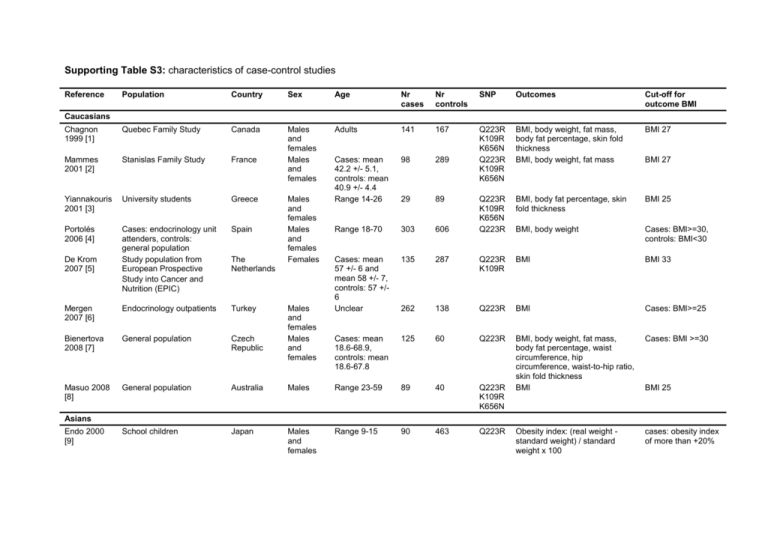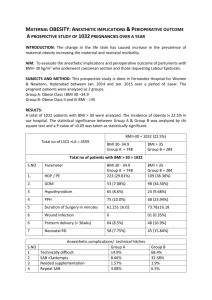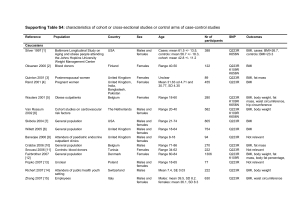Supporting Table S3: characteristics of case
advertisement

Supporting Table S3: characteristics of case-control studies Reference Population Country Sex Age Nr cases Nr controls SNP Outcomes Cut-off for outcome BMI Chagnon 1999 [1] Quebec Family Study Canada Adults 141 167 Stanislas Family Study France 98 289 BMI, body weight, fat mass, body fat percentage, skin fold thickness BMI, body weight, fat mass Yiannakouris 2001 [3] University students Greece Cases: mean 42.2 +/- 5.1, controls: mean 40.9 +/- 4.4 Range 14-26 Q223R K109R K656N Q223R K109R K656N BMI 27 Mammes 2001 [2] Males and females Males and females 29 89 BMI, body fat percentage, skin fold thickness BMI 25 Portolés 2006 [4] Cases: endocrinology unit attenders, controls: general population Study population from European Prospective Study into Cancer and Nutrition (EPIC) Spain Range 18-70 303 606 Q223R K109R K656N Q223R BMI, body weight Cases: BMI>=30, controls: BMI<30 135 287 Q223R K109R BMI BMI 33 Mergen 2007 [6] Endocrinology outpatients Turkey Cases: mean 57 +/- 6 and mean 58 +/- 7, controls: 57 +/6 Unclear 262 138 Q223R BMI Cases: BMI>=25 Bienertova 2008 [7] General population Czech Republic Cases: mean 18.6-68.9, controls: mean 18.6-67.8 125 60 Q223R Cases: BMI >=30 Masuo 2008 [8] General population Australia Males Range 23-59 89 40 Q223R K109R K656N BMI, body weight, fat mass, body fat percentage, waist circumference, hip circumference, waist-to-hip ratio, skin fold thickness BMI School children Japan Males and females Range 9-15 90 463 Q223R Obesity index: (real weight standard weight) / standard weight x 100 cases: obesity index of more than +20% Caucasians De Krom 2007 [5] The Netherlands Males and females Males and females Females Males and females Males and females BMI 27 BMI 25 Asians Endo 2000 [9] Reference Population Country Sex Age Nr cases Nr controls SNP Outcomes Cut-off for outcome BMI Wang 2006 [10] General population Taiwan >18 226 182 Q223R General population China 248 351 K109R K656N Popruk 2008 [12] Adolescents presenting at clinic for check-ups Thailand Males and females Cases: mean 47.8, SD 10.5, controls: mean 46.7, SD 11.3 Range 5-19 BMI, body weight, body fat percentage, waist circumference waist-to-hip ratio BMI Cases: BMI>=27, controls: BMI<25 Qu 2007 [11] Males and females Males and females 68 60 Q223R K109R K656N BMI, body weight, waist circumference, hip circumference Normal: 15-85 percentile, risk for overweight: 85-95 perc, overweight: >95 perc. USA Males Cases: mean 45.1 +/- 4.9, controls: mean 46 +/- 7.1 8 7 Q223R BMI cases: BMI 36.9 +/1.5, controls: BMI 23.3 +/- 0.9 unclear, obese: mean BMI 42.0, control: mean BMI 23.2 BMI 25 BMI 25 African Americans Considine 1996 [13] Autopsy cases Mixed populations Chung 1997 [14] people attending medical centers USA Males and females Adults and children 167 27 Q223R K109R K656N BMI Mattevi 2002 [15] People attending for routine blood test Brazil Mean 39.9 years 183 153 Q223R BMI, body weight, waist circumference Guízarmendoza 2005 [16] Duarte 2007 [17] Unclear Mexico Range 12-17 55 48 Q223R Cases: hypertension clinic patients, controls: blood donors Brazil Males and Females Males and Females Males and females Range 18-71 200 150 Q223R BMI, body weight, body fat percentage, waist-to-hip ratio, skin fold thickness BMI cases: BMI>=95 percentile, controls: BMI 5-85 percentile Cases: BMI>30, controls: BMI<=24 References 1. Chagnon YC, Chung WK, Perusse L, Chagnon M, Leibel RL et al. (1999) Linkages and associations between the leptin receptor (LEPR) gene and human body composition in the Quebec Family Study. International Journal of Obesity & Related Metabolic Disorders: Journal of the International Association for the Study of Obesity 23: 278-286. 2. Mammes O, Aubert R, Betoulle D, Pean F, Herbeth B et al. (2001) LEPR gene polymorphisms: associations with overweight, fat mass and response to diet in women. Eur J Clin Invest 31: 398-404. 3. Yiannakouris N, Yannakoulia M, Melistas L, Chan JL, Klimis-Zacas D et al. (2001) The Q223R polymorphism of the leptin receptor gene is significantly associated with obesity and predicts a small percentage of body weight and body composition variability. Journal of Clinical Endocrinology & Metabolism 86: 4434-4439. 4. Portoles O, Sorli JV, Frances F, Coltell O, Gonzalez JI et al. (2006) Effect of genetic variation in the leptin gene promoter and the leptin receptor gene on obesity risk in a population-based case-control study in Spain. Eur J Epidemiol 21: 605-612. 5. de Krom M, van der Schouw YT, Hendriks J, Ophoff RA, van Gils CH et al. (2007) Common genetic variations in CCK, leptin, and leptin receptor genes are associated with specific human eating patterns. Diabetes 56: 276-280. 6. Mergen H, Karaaslan C, Mergen M, Deniz OE, Ozata M (2007) LEPR, ADBR3, IRS-1 and 5-HTT genes polymorphisms do not associate with obesity. Endocr J 54: 89-94. 7. Bienertova-Vasku J, Bienert P, Tomandl J, Forejt M, Vavrina M et al. (2008) No association of defined variability in leptin, leptin receptor, adiponectin, proopiomelanocortin and ghrelin gene with food preferences in the Czech population. Nutr Neurosci 11: 2-8. 8. Masuo K, Straznicky NE, Lambert GW, Katsuya T, Sugimoto K et al. (2008) Leptin-receptor polymorphisms relate to obesity through blunted leptin-mediated sympathetic nerve activation in a Caucasian male population.[see comment]. Hypertension Research - Clinical & Experimental 31: 1093-1100. 9. Endo K, Yanagi H, Hirano C, Hamaguchi H, Tsuchiya S et al. (2000) Association of Trp64Arg polymorphism of the beta3-adrenergic receptor gene and no association of Gln223Arg polymorphism of the leptin receptor gene in Japanese schoolchildren with obesity. International Journal of Obesity & Related Metabolic Disorders: Journal of the International Association for the Study of Obesity 24: 443449. 10. Wang TN, Huang MC, Chang WT, Ko AM, Tsai EM et al. (2006) G-2548A polymorphism of the leptin gene is correlated with extreme obesity in Taiwanese aborigines. Obesity 14: 183-187. 11. Qu Y, Yang Z, Jin F, Sun L, Zhang C et al. (2007) Analysis of the relationship between three coding polymorphisms in LEPR gene and obesity in northern Chinese. Obes Res Clin Pract 1: 261-266. 12. Popruk S, Tungtrongchitr R, Petmitr S, Pongpaew P, Harnroongroj T et al. (2008) Leptin, soluble leptin receptor, lipid profiles, and LEPR gene polymorphisms in Thai children and adolescents. International Journal for Vitamin & Nutrition Research 78: 9-15. 13. Considine RV, Considine EL, Williams CJ, Hyde TM, Caro JF (1996) The hypothalamic leptin receptor in humans: identification of incidental sequence polymorphisms and absence of the db/db mouse and fa/fa rat mutations. Diabetes 45: 992-994. 14. Chung WK, Power-Kehoe L, Chua M, Chu F, Aronne L et al. (1997) Exonic and intronic sequence variation in the human leptin receptor gene (LEPR). Diabetes 46: 1509-1511. 15. Mattevi VS, Zembrzuski VM, Hutz MH (2002) Association analysis of genes involved in the leptin-signaling pathway with obesity in Brazil. International Journal of Obesity & Related Metabolic Disorders: Journal of the International Association for the Study of Obesity 26: 1179-1185. 16. Guizar-Mendoza JM, Amador-Licona N, Flores-Martinez SE, Lopez-Cardona MG, Ahuatzin-Tremary R et al. (2005) Association analysis of the Gln223Arg polymorphism in the human leptin receptor gene, and traits related to obesity in Mexican adolescents.[see comment]. J Hum Hypertens 19: 341-346. 17. Duarte SF, Francischetti EA, Genelhu VA, Cabello PH, Pimentel MM (2007) Lepr p.Q223r, beta3-ar p.W64r and lep c.-2548G>A gene variants in obese brazilian subjects. Genetics & Molecular Research 6: 1035-1043.









